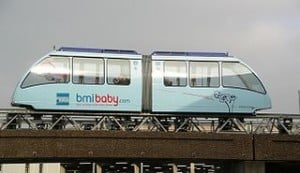During the summer of 1984, I booked a roundtrip flight from California to Maryland and back. I remember riding an Amtrak San Joaquin from Fresno (in the San Joaquin Valley) to Richmond (located on the east side of San Francisco Bay). At the Richmond station, one can make a cross-platform switch to BART, the Bay Area Rapid Transit system, and it was there that I boarded an electrified BART rail train bound for the Coliseum/Oakland Airport station.
If I recall correctly, it was at the latter station that I transferred to an airport shuttle bus where I was able to complete the land-based portion my outbound journey, a move that was indubitably far less complicated in my view than if I had remained on the Amtrak train going the rest of the way to Oakland’s 16th Street station, at which point a way would need to be found to get from there to the airport itself.

Carrying this idea one step farther, wouldn’t it be nice if BART served the airport directly? That it doesn’t, perhaps the next best thing would be a cross-platform change at Coliseum/Oakland Airport to a rail-based shuttle of some sort which allows for electric train transfer to and from the airport. Well, believe it or not, that day is not far off as just such a BART-airport connector is already underway.
“After years of hoping, planning and fighting, BART’s long-awaited and controversial Oakland Airport Connector is taking shape. Construction crews have been working on the 3.2-mile link between the Coliseum/Oakland Airport BART Station and the airport since late 2010,” San Francisco Chronicle reporter Michael Cabanatuan wrote.
The connector is slated to open in late 2014, according to the Chronicle reporter.
Interesting to note is this air-rail shuttle will be cable-operated and driverless, the connection between the two endpoints taking eight minutes.
“It will replace AirBART, a shuttle bus operated by the Port of Oakland,” Cabanatuan wrote.
Had the Oakland Airport Connector (OAC) been up and running when I made my mid-’80s rail-air journey, not only would this have been a convenient way to travel but a much more environmentally friendly one at that.
In the U.S., rail transit-airport connectors like OAC; namely, the Phoenix SkyHarbor Airport SkyTrain, and AirTrain systems at international airports in San Francisco (SFO, Calif.) and New York (JFK, N.Y.), for example, in addition to other people-mover type systems that afford riders a viable travel option in getting from point A to point B, are gaining acceptance and growing in popularity.
I envision a day when every major U.S. airport has a rail-based connector of some type. Puzzling is why the domestic rail-transit/airport connector idea took as long as it took to take off.
– Alan Kandel